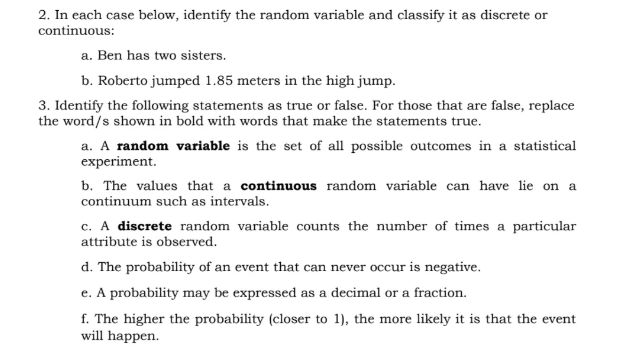2. In each case below, identify the random variable and classify it as discrete or continuous: a. Ben has two sisters. b. Roberto jumped 1.85 meters in the high jump.
2. In each case below, identify the random variable and classify it as discrete or continuous: a. Ben has two sisters. b. Roberto jumped 1.85 meters in the high jump.
A First Course in Probability (10th Edition)
10th Edition
ISBN:9780134753119
Author:Sheldon Ross
Publisher:Sheldon Ross
Chapter1: Combinatorial Analysis
Section: Chapter Questions
Problem 1.1P: a. How many different 7-place license plates are possible if the first 2 places are for letters and...
Related questions
Question

Transcribed Image Text:2. In each case below, identify the random variable and classify it as discrete or
continuous:
a. Ben has two sisters.
b. Roberto jumped 1.85 meters in the high jump.
3. Identify the following statements as true or false. For those that are false, replace
the word/s shown in bold with words that make the statements true.
a. A random variable is the set of all possible outcomes in a statistical
experiment.
b. The values that a continuous random variable can have lie on a
continuum such as intervals.
c. A discrete random variable counts the number of times a particular
attribute is observed.
d. The probability of an event that can never occur is negative.
e. A probability may be expressed as a decimal or a fraction.
f. The higher the probability (closer to 1), the more likely it is that the event
will happen.
Expert Solution
This question has been solved!
Explore an expertly crafted, step-by-step solution for a thorough understanding of key concepts.
This is a popular solution!
Trending now
This is a popular solution!
Step by step
Solved in 2 steps

Recommended textbooks for you

A First Course in Probability (10th Edition)
Probability
ISBN:
9780134753119
Author:
Sheldon Ross
Publisher:
PEARSON


A First Course in Probability (10th Edition)
Probability
ISBN:
9780134753119
Author:
Sheldon Ross
Publisher:
PEARSON
